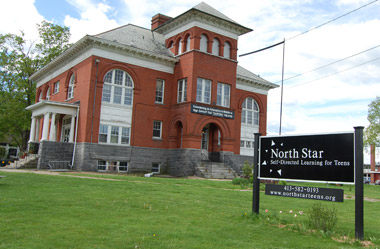As a kid in Shaker Heights, Ohio, Ken Danford liked school. He took challenging classes and did well. He found extracurricular activities that were meaningful to him, like competing on the debate team and starting a race-relations group. “I had a purpose and I got a lot of honors for it,” Danford recalls. “I was trusted and respected.”
Not the likeliest backstory for a guy who now speaks of “saving” kids from school, and who leads a learning center—please, don’t call it a school—whose bumper sticker reads: “Learning is Natural. School is Optional.”
Danford is the executive director of Hadley’s North Star, a “self-directed learning center” for teens who have left school. North Star operates like a club; members pay an annual fee and can come to the center to take classes and one-on-one tutorials, join group activities (on a recent day, plans were underway for a rock-climbing trip and a new campus garden) and socialize. Staff teach courses and advise students and families on how to navigate the world of learning outside of school (including, for kids under the legal drop-out age of 16, how to satisfy state homeschooling requirements). There are no grades, no diplomas, no attendance requirements.
“We’re taking no control over you,” Danford says. “Come in if you want. Don’t come in. Walk your dog. Read at home in your pajamas. Go live. Have a life. … We’re not trying to replace school. Our job is to get you out of school.”
That is, if you want out. “I’m not dogmatic that school is awful, that no one should go to school,” he says; indeed, his own kids are happily enrolled in school. But, he adds, “I am dogmatic that school is optional.”
*
Danford’s path from happy high schooler to advocate for alternative education included an undergraduate degree from Amherst, graduate studies in education reform at Brown, and a number of years as a middle-school history teacher, including several in Amherst—an experience he describes as disillusioning.
Danford entered teaching, he says, full of idealism, excited to teach kids about civil rights and the women’s movement, eager to help prepare them to change the world. But the reality of the classroom was sobering; his students, he found, had little interest in what he was offering.
“They didn’t want to be there,” he says. “They didn’t care.” Instead, his students largely were focused on doing what they needed to do to get by. “It’s what school expects of them. … And I was supposed to fuss at kids about tardiness, their hats, bathroom passes.” Rather then helping kids love learning, he felt, he was inadvertently teaching them to hate it.
Danford’s frustrations were shared by one of his Amherst Junior High colleagues, a science teacher named Josh Hornick. The two young teachers carpooled, coached volleyball together, and commiserated about the challenges they faced in the classroom. The problem, they realized, wasn’t the kids, but the system in which the kids found themselves.
Then one day Hornick gave Danford a book to read: Grace Llewellyn’s The Teenage Liberation Handbook, a manifesto for “unschooling,” a philosophy that holds that kids learn best not in school, or even in a structured homeschooling setting, but through real-life experience. “Healthy kids can teach themselves what they need to know, through books, various people, thinking, and other means,” Llewellyn wrote (although, she warned, “A freshly unschooled person may at first be a lousy learner; like cigarettes, school-style passivity can be a slow habit to kick.”)
Danford was skeptical when Hornick handed him Llewellyn’s book (“I was the typical teacher: ‘They’ll learn nothing without me.’”) Then he read the book in one night and was sold. “It blew me away,” he recalls. “These people were onto something. What would it take to make it mainstream?”
Danford and Hornick quit their teaching jobs and in 1996 opened Pathfinder Learning Center, which would later change its name to North Star. Initially, the two were the center’s co-directors; while Hornick no longer works there, he still serves on North Star’s board. A small staff advises students and teach courses; some classes and tutorials are taught by volunteers from the community or local colleges.
*
North Star operates out of the former Russell Street School, on Route 9 in Hadley. It’s an old (and, in some spots, rather musty-smelling) but handsome building, with a red brick exterior and lots of dark woodwork inside. Origami peace cranes hang from the ceiling at the main entrance, and the walls are decorated with photos of member trips, one to volunteer with a reforestation project in Costa Rica, and another to Puerto Rico, to the Peace and Justice Camp in Vieques. There are plants everywhere, and a couple of dogs wander the building.
On a recent afternoon, a group of kids was attending a boisterous physical-theater class, while a smaller group sat in the hallway rehearsing lines from As You Like It. A few teens were reading in the upstairs library; outside, another was working on his French with a tutor.
More traditional subjects, like languages and math, are taught in individual tutorials. Members can also attend group classes, which tend toward the non-conventional: Revolutionary Literature; Ancient Living Skills (“fire and tool making, and more”); Five Elements (“We will create a five-element environment with areas and altars for each element. Through movement, stretches, artistic creations, and discussions, we’ll learn the seasons, emotions, archetypes, and meridians … associated with each element”). The current schedule also includes a history course about the U.S. presidents; a class on building a computer; a math class called “the Beauty of Numbers”; world religions; anthropology; a writing workshop; music classes; yoga, meditation and belly-dancing.
North Star currently has about 70 members, who pay between $2,500 to $7,500 a year, depending on how many days a week they come to the center. No one has ever been turned away from North Star for lack of money, Danford says.
Students and their families meet regularly with staff to discuss their passions and plans, and what North Star can do to help them achieve them, from helping them find a volunteer project that suits their interests to charting a course toward college. Some members get their GED; some take the state-administered “Ability to Benefit” test, which allows them to enroll in college without a high school diploma or GED. It’s not unusual, Danford says, for a North Star teen to start off with a class or two at one of the local community colleges, then transfer to a four-year school (including, in what Danford calls North Star’s “headline stories,” places like Brown, M.I.T., Amherst and Mount Holyoke). Some leave and get jobs, start their own businesses, do community-service work.
Kids typically come to North Star between the ages of 13 and 15, and stay two or three years. They leave when they’re ready, Danford says. “You don’t need our stamp of approval to say you’re competent to move on.”
*
Perhaps as vital as North Star’s classes is the social scene it provides. In a lounge off the lobby, kids gather to talk, listen to music and read. “That horrifies people, that kids can sit around and do nothing,” Danford says. “But that’s important.”
Some North Star members are long-time homeschoolers who use the center as a social and academic supplement. Others are kids who’ve left traditional school situations, in some cases in crisis, or fast approaching one. Sophie Brown, a poised, friendly 14-year-old from South Deerfield, came to North Star this year after leaving Frontier Regional. While she liked elementary school, Brown says, she was deeply unhappy at Frontier. “There was kind of a mean atmosphere,” she says; other kids teased her for having short hair and for raising her hand in class. “It was kind of getting me down.”
Brown speaks of her experience at North Star with a palpable sense of relief. The other kids are nice and accepting she says, and the courses—she’s taking the Presidents class and doing writing and photography workshops, among other things—suit her interests. “I’m going to stay here for the next four years, because I really love it,” Brown says, adding that her initial months at North Star have been spent, in part, “recuperating” from her negative school experience. “I’d say it’s a real life-changer for me.”
Catherine Gobron, North Star’s program director, understands what many of the kids there have experienced; as a teen, she says, she got good grades but had a bad attitude: “I didn’t take well to authority.” Gobron left school her senior year when it became clear that she wasn’t going to graduate, but eventually went on to college and then graduate school, earning a master’s in education.
Working at North Star allows her to develop long-term relationships with both the kids and their families. And, because she’s not bound by the expectations of a school setting—testing, rules, bureaucracy—“I get to meet them where they are. I don’t have to get them to any set place. I get to be with them in a very real way,” she says. “To not have my own agenda, I can support them and be there for them.”
That’s what education should be like—although, Gobron concedes, it can be hard for many families to think outside the school model. “When we send our kids to school … we want all the doors to be open in the future. And that’s the gauntlet they have to go through,” she says. “But the means don’t justify the ends in many cases.”
The above story appeared in Nurture, the Valley Advocate’s new parenting supplement.



